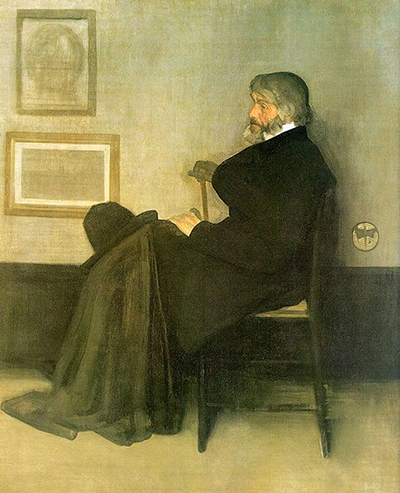Modeled after the first Arrangement in Grey and Black by Whistler in which Whistler painted his mother, the Arrangement in Grey and Black No. 2: Portrait of Thomas Carlyle was begun in 1872 and finished by the summer of 1873.
The formal technique used is much more dominant in this painting than in the first Arrangement. The protruding shape of Carlyle's coat, which obsessed Whistler, is foregrounded while the face, by far the brightest patch of colors in the whole painting, is somewhat muted and less emblematic. The strikingly restrained vigor of Carlyle's pose is enhanced by the draping overcoat that hides his feet and the hand holding the stick in the background. The two frames holding indistinguishable material help amplify the background with some visual interest while emphasizing the vertical nature of the whole composition along with the hanging overcoat and the legs of the chair.
This vertical nature is also reinforced on the canvas by Whistler's habit of scraping down and reworking, a habit that angered Carlyle to no end. The small butterfly insignia at the bottom right is typical of many of Whistler's work. The composition also uses darker and livelier colors than Artist's Mother, giving it a crisp sense of mood without much grandeur or drama. This dark tone also helps highlight Carlyle's face. The painting was a result of four earlier preparatory drawings in oil and a series of sketches and variations, including one without the overcoat hanging of Carlyle's lap. The final painting is 171 × 143.5 cm., oil on canvas.
Unlike the Artist's Mother, the three dimensional perspective is also accentuated by the slight turn of Carlyle's head towards the painter. The overlap of the beard over the collar, the somber expression of the face and the calm but purposeful residing of the hand in the dead center of the painting are all typical of Whistler's evocation of images by finding harmony between artistic form and the mundane. The picture was refused purchase by the National Portrait Gallery in London after the death of Carlyle. In 1891, the City of Glasgow purchased the painting on the insistence of the Glasgow School of artists and designers, thus becoming the first of Whistler's work to enter a public collection. It is now on display at the Kelvingrove Art Gallery and Museum, Glasgow, Scotland.




